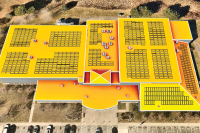Quantifying solitude: Building a lockbox around the Chattooga River
The forest service has pledged to ensure a solitary wilderness experience on the upper Chattooga River, even if it means imposing limits on the number of recreational users who can enter the area, including day hikers.
If such steps are taken, the Upper Chattooga would join a small handful of elite wilderness settings in North America where use is managed so stringently that permits are required simply for day hiking.
The forest service doesn’t believe use has reached that level yet, but intends to monitor encounters among wilderness users and put the brakes on if a certain threshold is reached. That threshold for solitude is subjective, yet rooted in social science, said Tony White, the manager for planning and recreation in the Francis/Marion National Forest. Research has measured perceptions among hikers, backpackers, fishermen and paddlers to determine how many encounters are too many.
The upper Chattooga is hardly heavily used. In fact, it’s quite the opposite, which is exactly why it has been singled out for the rigorous management.
“We are setting the stage for maintaining that solitude,” said White. “It won’t stay the same unless we put some of those limits in place.”
It’s a noble goal, yet a difficult one, said Wayne Jenkins, executive director of Georgia Forest Watch, which has played a watchdog role along the Chattooga River.
Related Items
“At what point does it no longer feel wild? We are very challenged to legally quantify experience and emotions, which are all wrapped up in how we relate to nature,” Jenkins said. “How many groups would you need to run into before you start feeling like this place is crowded, that I am not having the experience I was seeking? There is no magic number.”
Yet the forest service has attempted to identify the magic numbers, which vary among user groups (see chart).
Plans to start monitoring encounters in the upper Chattooga River corridor were borne out of a long-running debate over paddling. At the insistence of paddlers, the forest service has spent the past four years studying whether to lift a long-standing paddling ban.
Hikers and fishermen claimed their wilderness experience would be degraded if paddlers are allowed on the river. Paddlers, however, pointed out the hypocrisy of putting restrictions on them but not on other users.
The result is a plan to limit encounters for all users — paddlers, hikers and fishermen alike. While the paddling debate has captured headlines, White believes the forest service’s larger strategy of protecting solitude is noteworthy.
“I think a lot of people are missing that element,” White said. “To me, that is such a critical decision that we are drawing a line on those encounter levels.”
The forest service hasn’t figured out exactly how it will monitor encounters between users, however. A workshop with paddlers, hikers and fishermen will be held this fall to hopefully arrive at a strategy.
White said his idea is to engage a third-party to monitor recreation levels rather than relying on users themselves to report on how many encounters they are having. The debate over paddling has been so passionate, White fears opposing sides wouldn’t trust the data reported by the other side.
If hikers reported they saw five groups of paddlers — one more than the allowed threshold for maintaining a wilderness experience — the paddling community would question whether the hikers were artificially inflating the numbers in order to impose a permit system on paddlers.
“We need some independent collection. People will tend to accuse each other of making up things,” White said. “Early in this process we really need to make sure instead of creating a situation where people stay divided we create a situation where they start coming back together.”
Unprecedented limits
Only places like the Boundary Waters, a canoe Mecca in Minnesota, and Denali National Park in Alaska, attempt to impose limits on the number of people who can set foot in an area on a given day.
The concern over encounters is an asymmetrical one, according to Mark Singleton, the director of American Whitewater, a national paddling advocacy group with its head office in Sylva.
While hikers and fishermen object to spying a paddler in their midst, the feeling isn’t mutual, Singleton said.
“If I am boating and I see a hiker that has no bearing,” Singleton said. The same goes for a fisherman.
“I paddle over to the other side of the river, float by, wave and that’s it,” Singleton said.
But, if preserving solitude is a stated mission along the Chattooga, Singleton supports limits being placed on all users rather than picking one to keep out while allowing a free-for-all for the others.
“That was one of our concerns, that this resource is getting hammered but the only management in place was a ban on boating,” Singleton said.
It’s one of the few areas where opponents seem to agree.
“American Whitewater had a valid point,” said Buzz Williams with the Chattooga Conservancy, which wanted to see the boating ban stay in place. “If you are going to ban one use you have to rein in the damage from overuse by campers, hikers, et cetera.”
But Williams questioned whether the mission is possible, and whether the limits will ultimately be arbitrary. For one, the perception of encounters is constantly shifting. When Williams started paddling the Chattooga in 1968, his experience was diminished if he saw anyone else at all. The entire river probably only saw 200 paddlers a year.
“If you ask people now, the majority of which are young male boaters from Atlanta who are dying to escape the beltway, they would think 80,000 people a year going down the river is not that big a deal,” Williams said. “Carrying capacity changes and their perception of encounters changes over time and between user groups.”
Limiting encounters comes with a price, however. While those who do venture into the upper Chattooga will be guaranteed a solitary wilderness experience, not everyone who wants to go may get to go.
“People aren’t willing to give those things up very easily, but my idea of conservation is seeing the wisdom of giving up something to protect the greater good,” Williams said.
It’s especially important to protect those remaining wild places as population growth and sprawl create more and more demand for solitude, Williams said. But the answer isn’t always easy.
“How do we share the resources in a way we can break way from our hectic lives and get that renewal and then go back to our hectic lives?” Jenkins asked.








